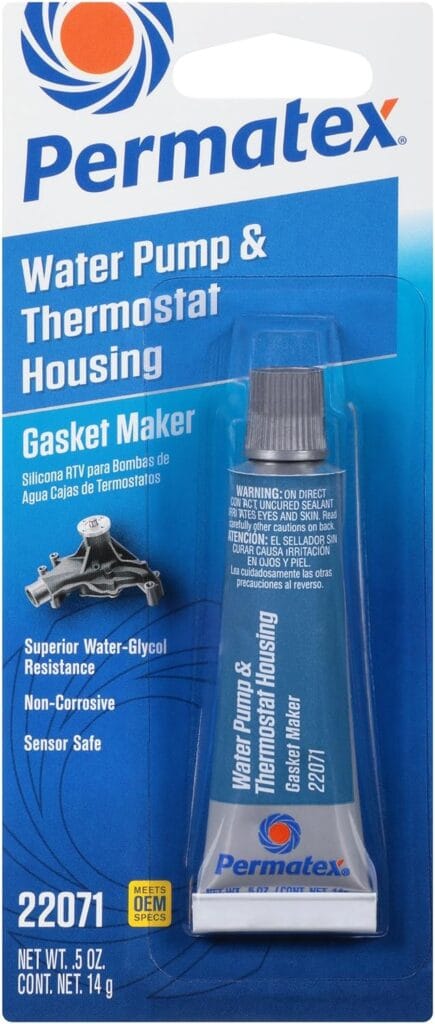Water pumps are essential for circulating coolant through the engine, preventing it from overheating. When a water pump starts leaking, it compromises its ability to perform this vital function, which can lead to engine damage.
The causes of water pump leaks can vary, but understanding why they happen and how to address them is crucial for effective repairs.

Permatex 22071 is a non-corrosive, sensor-safe RTV silicone gasket maker. It is specifically formulated for water pumps and thermostat housings. This blue silicone offers high resistance to water and glycol, providing a reliable seal. It boasts superior adhesion and flexibility and can function as both a gasket maker and a gasket dressing. It’s designed to withstand temperatures ranging from -65°F to 500°F (-54°C to 260°C) intermittently. To use, ensure surfaces are clean and dry, apply a continuous bead, assemble parts immediately, and allow 24 hours for a full cure.
The Role of a Water Pump
The water pump is a critical component in maintaining engine temperature. It pumps coolant through the engine’s radiator and other cooling channels, absorbing heat and ensuring the engine doesn’t overheat.
Without a properly functioning water pump, the engine will not receive the necessary coolant flow, leading to severe overheating. This is why a water pump leak must be dealt with quickly to avoid engine damage or other mechanical failures.
Causes of Water Pump Leaks
Several factors can cause a water pump to leak, most commonly worn seals or gaskets. Over time, the seals that prevent coolant from leaking around the water pump’s moving parts may degrade. This can be due to age, excessive heat, or prolonged exposure to contaminants in the coolant.
Coolant can begin to leak when the seals fail, which may cause overheating if not addressed. Another possible cause is the presence of corrosion on the water pump housing or other parts of the pump, which can weaken its structural integrity and lead to leaks.
Worn or Damaged Seals
Seals are designed to keep coolant inside the pump and prevent leaks. The constant pressure and temperature fluctuations can cause these seals to wear out. When this happens, the coolant can escape from the pump, either as a slow drip or as a more significant leak.
A worn or damaged seal is one of the most common reasons for a leaking water pump, and it is often the first place to check when diagnosing a leak.
Corrosion and Wear
Corrosion is another common culprit for water pump leaks. If coolant isn’t regularly replaced or is contaminated with dirt or debris, it can lead to corrosion in the pump housing or other components.
Rust and other forms of corrosion can eat away at the metal, weakening its structural integrity and eventually causing leaks.
Temperature and Pressure Changes
Extreme temperature fluctuations or pressure surges can also contribute to water pump leaks. A water pump operates under significant pressure, and any sudden increase or decrease in pressure can stress the components, leading to cracks or leaks.
For instance, if the engine overheats, the pressure in the cooling system can rise dramatically, which may cause the pump to fail or leak.
Coolant Contamination

Coolant contamination can occur when foreign particles such as dirt, rust, or oil enter the cooling system. This can happen if the radiator is damaged or if the coolant isn’t flushed regularly.
Contaminated coolant can cause the seals inside the water pump to wear out more quickly. It can also cause buildup that can clog the pump, reducing flow and increasing stress on the pump’s parts.
Inadequate Maintenance
One of the most common reasons for water pump leaks is simply poor maintenance. The water pump relies on regular inspections, coolant changes, and flushing to operate at its best. If the system isn’t properly maintained, it can lead to premature wear and tear.
Best Stop Leak Products for Water Pumps
If you’re experiencing a leak in your water pump and need a quick solution, several stop-leak products are available. These products work by temporarily sealing small leaks in the pump or coolant system.
They can be a good short-term solution, especially if you’re unable to repair or replace the water pump immediately. It is essential to remember that stop-leak products are only a temporary fix and may not resolve the underlying issue.
Types of Stop Leak Solutions
There are various types of stop-leak products designed for water pumps and coolant systems. Some are liquid-based solutions that you pour directly into the coolant reservoir.
These liquids work by reacting with the coolant and forming a seal over the leak. Others are powder or pellets that dissolve into the system and create a temporary seal over the leak.
Advantages of Using Stop Leak Products
The primary benefit of using stop-leak products is They are relatively easy to apply and can offer a quick solution for a leaking water pump.
They can be particularly useful in emergencies, allowing you to keep your vehicle running long enough to get it to a repair shop.
Limitations of Stop Leak Products
While stop-leak products may provide a temporary fix, they are not a permanent solution. They can be effective at sealing small leaks but cannot repair more significant damage, such as a cracked pump housing or a broken seal.
These products may cause other issues in the cooling system if used improperly. For example, they can clog hoses, radiators, or other components, which can lead to further damage.
FAQ’s
Will water pump leak when engine is off?
Yes, a water pump can definitely leak when the engine is off. This often happens if the internal seals are failing. As the engine cools, pressure in the cooling system drops.
This can allow more coolant to seep out through a worn seal or the weep hole. You might see a puddle under your car after it’s been parked. This is a clear sign that the water pump needs attention.
Why is my water pump leaking from the bottom?
A water pump often leaks from a small hole at the bottom. This is called a “weep hole.” It’s a built-in indicator. The weep hole is designed to show when the internal seals are failing.
Coolant leaking from it means the seals are worn. This is a clear sign that your water pump needs replacement soon. Ignoring it can lead to overheating and engine damage.
Water pump gasket leak
A water pump gasket leak is a common issue. You might see coolant dripping. This means the seal around your water pump is bad. If you ignore it, your engine can overheat.
Overheating causes major engine damage. Fix it fast. Replacing the gasket usually solves the problem. It’s a key repair for your car’s health.
Water pump stop leak sealer
Water pump stop leak sealer is a temporary fix. It’s a liquid you add to your coolant. It aims to plug small leaks in your cooling system. This can stop minor water pump gasket drips.
However, it’s not a permanent solution. It can sometimes clog other parts. A proper repair, like replacing the gasket, is best. Use sealer only for emergencies.
Radiator water pump stop leak
Radiator and water pump stop leak sealers offer a temporary fix. These liquids are added to your car’s coolant. They contain particles that aim to plug small leaks in the radiator, water pump, or other cooling system parts.
It’s a quick solution for minor drips, buying you time. However, it’s not a permanent repair. It can sometimes clog other cooling system components. For lasting results, professional repair, like replacing the faulty part, is always recommended.
Conclusion
Water pump leaks are usually caused by worn-out seals, corrosion, temperature and pressure fluctuations, coolant contamination, or inadequate maintenance.
While stop-leak products can offer a temporary solution, they are not a substitute for proper repair or replacement of faulty components.
If you notice a water pump leak, it’s crucial to address the underlying cause of the problem to prevent further damage to your engine.

